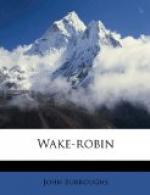Besides being walkers, the larks, or birds allied to the larks, all sing upon the wing, usually poised or circling in the air, with a hovering, tremulous flight. The meadowlark occasionally does this in the early part of the season. At such times its long-drawn note or whistle becomes a rich, amorous warble.
The bobolink, also, has both characteristics, and, notwithstanding the difference of form and build, etc., is very suggestive of the English skylark, as it figures in the books, and is, no doubt, fully its equal as a songster.
Of our small wood-birds we have three varieties east of the Mississippi, closely related to each other, which I have already spoken of, and which walk, and sing, more or less, on the wing, namely the two species of water-thrush or wagtails, and the oven-bird or wood-wagtail. The latter is the most common, and few observers of the birds can have failed to notice its easy, gliding walk. Its other lark trait, namely singing in the air, seems not to have been observed by any other naturalist. Yet it is a well-established characteristic, and may be verified by any person who will spend a half hour in the woods where this bird abounds on some June afternoon or evening. I hear it very frequently after sundown, when the ecstatic singer can hardly be distinguished against the sky. I know of a high, bald-top mountain where I have sat late in the afternoon and heard them as often as one every minute. Sometimes the bird would be far below me, sometimes near at hand; and very frequently the singer would be hovering a hundred feet above the summit. He would start from the trees on one side of the open space, reach his climax in the air, and plunge down on the other side. His descent after the song is finished is very rapid, and precisely like that of the titlark when it sweeps down from its course to alight on the ground.
I first verified this observation some years ago. I had long been familiar with the song, but had only strongly suspected the author of it, when, as I was walking in the woods one evening, just as the leaves were putting out, I saw one of these birds but a few rods from me. I was saying to myself, half audibly, “Come, now, show off, if it is in you; I have come to the woods expressly to settle this point,” when it began to ascend, by short hops and flights, through the branches, uttering a sharp, preliminary chirp. I followed it with my eye; saw it mount into the air and circle over the woods; and saw it sweep down again and dive through the trees, almost to the very perch from which it had started.




